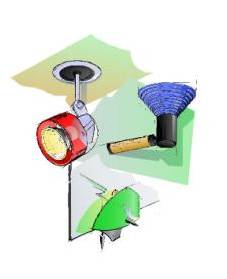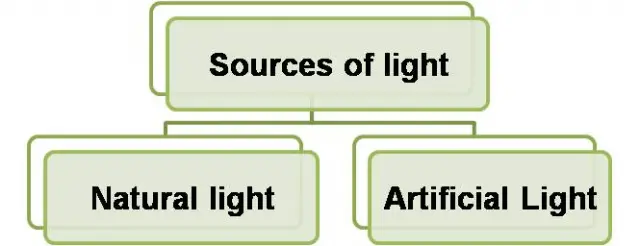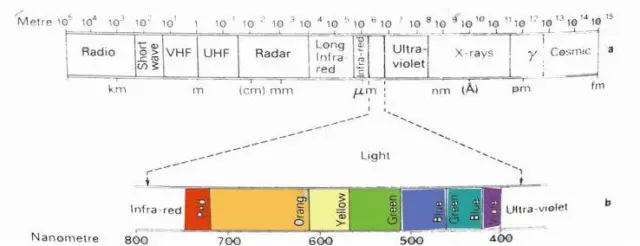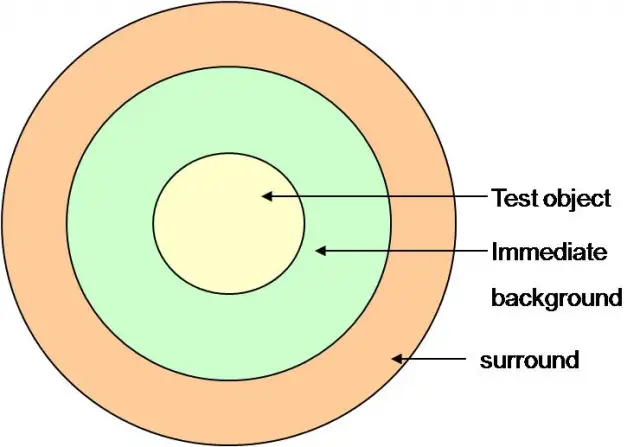
- Lighting is an integral part of architectural design.
- It determines the utilitarian and the aesthetic environment provided by a designer, thus calling for the most careful planning and highest skills.
- The variations in the amount, direction and color of lighting enable the designer to create a dynamic architectural expression.
- It thus helps break the monotony of static interiors.
- It is essential to attain the right balance between natural and artificial lighting in order to create comfortable, efficient and aesthetically appealing spaces.
SOURCES AND NATURE OF LIGHT
Light:
What we perceive as light is a narrow wavelength band of electromagnetic radiation from about 380 to 780 nm.


In the above energy radiation we see dual characteristics –
a) Particle nature ( carries photons as energy particles.
b) Wave nature ( transverse waves).
Transmission:
- Materials that allow large parts of incident light to pass right through are called “transparent”.
- “Opaque” materials block the passage of light. Behind an opaque object there will be no light.
- “Translucent” materials transmit a part of light, they break its path, scatter it in all directions, creating diffused light.
- Incident light may be reflected (r), absorbed(a) and transmitted(t).
- In all cases r + a + t = 1.
- In opaque objects t= 0, r + a = 1
Reflection:
Materials are selective in their reflectance. They may absorb certain wavelengths, and reflect the remainder. Their color is thus due to subtractive process. A mixture of all colors is black as it absorbs all wavelengths. No mixture of pigments can be white.
PROPERTIES OF LIGHT
Colored Light:
Colored light can be mixed from different sources, the resultant color will of the range which is the sum of the components. It may also be produced using filters. They have a high but selective transmittance.

Surface Colors: The munsell system – distinguishes three color concepts.
- Hue – Concept of color , using common color terms like red, yellow but further subdividing each into 5.
- Value – The subjective measure or reflectance, light or dark appearance, according to a scale from 0 ( absolute black ) to 10 (absolute white) .
- Chroma – The degree of colorfulness or intensity of color , distinguishing 14 classes. A low chroma would be almost grey ; the brightest colors have a chroma of 12 to 14.
LIGHTING AND VISION

- Contrast between the details of a task and its immediate background.
- Luminance of the task.
- Size of task.
- Time of viewing.
Out of all the above, luminance resulting from the amount of light on a task can be controlled readily and extensively.
Factors Affecting Visual Recognition
- Contrast:
Visibility is at a maximum when the luminance contrast and the color contrast (if present) of details with the background is greatest, Eg- the use of white chalks on black boards.
- Luminance Of The Task:
It is product of task reflectance and the quantity of illumination incident on the task.
- Size Of Task:
Within a given range, the larger the task detail, the easier viewing it will be. The smallest detail which can be detected becomes progressively smaller with an increase in luminance of the task .
- Time Of Viewing:
The time needed to recognize the object of a given size and background is reduced as the luminance increases.
PHOTOMETRIC QUANTITIES
| Light Flux (Φ) | Light Intensity (I) |
Illumination (E) | Luminance (L) |
| Total quantity of light emitted per second. | Light flux emitted in a particular direction by the source. | Quantity of light incident on a surface /(area)m2. | Brightness of surface. |
| lumens | I=Φ2/ ω | E = Φ/m2 | L = I/M |
| Value given by manufacturer. | Candela | Lux = lumens/m2 | cd /m2 |
To learn more about lighting, visit:
This presentation was created by: Pooja Mahendra, Priyanka Pande

Leave a Reply
You must be logged in to post a comment.